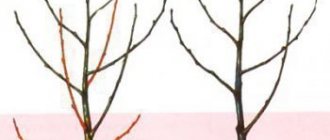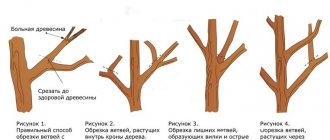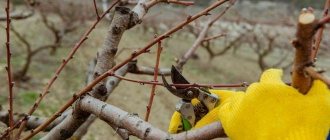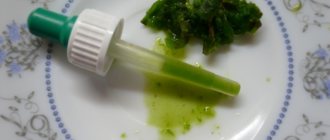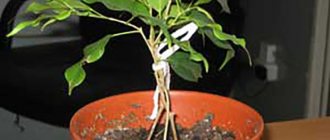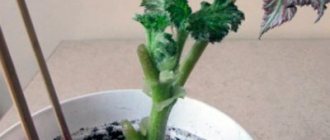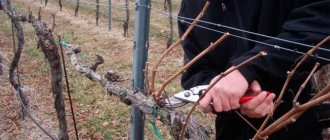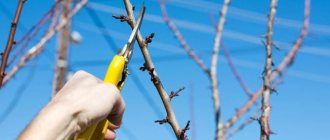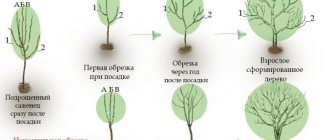Why are fruit trees pruned?
Fruit trees, including quince, give a rich harvest if several branches are removed.
- Pruning slows down the growth of the tree.
- Stimulates the growth of generative branches.
- Increases the number of fruits.
- Extends the life of the plant.
- Sanitary pruning helps to get rid of the possible spread of diseases and pests.
Quince is a light-loving crop that requires care, and it is necessary to strive to clear the internal space of its crown from excess branches.
Features of quince growth
In the first years from the beginning of growth, quince produces a large number of shoots more than a meter long. But when the tree enters the fruiting period, its growth slows down. Depending on the variety, the main location of the ovaries changes.
- Young trees and low-growing varieties bear fruit in elongated annual growths.
- Other quince trees produce fruits on perennial generative branches - shoots that grow over large branches. They bear fruit within 5-10 years.
Skeletal branches should be evenly spaced along the trunk, and sunlight should penetrate freely throughout the entire crown.
The branches must be cut to the bud, which faces outward from the crown.
In the south, quince seedlings are often formed into a bush - four or six to seven trunks that come from the root. At each of them, the direction of the side branches is controlled so that they do not interfere with each other.
Trimming Features
Tree pruning is an essential part of tree care; it serves several purposes:
- improving the growth of individual branches;
- increased fruiting;
- reducing the size of the tree;
- giving attractiveness;
- preventing the spread of harmful insects.
All this fully applies to Japanese quince; it takes pruning well.
There are 3 types of pruning:
- sanitary;
- for crown formation;
- rejuvenating.
Sanitary pruning to protect against pests is carried out in the spring. It is necessary to remove diseased, old, weak and frost-damaged branches. For other purposes, it is advisable to trim tree branches in the fall, when the harvest is over. At the end of summer, you can pinch out shoots that have actively grown over the spring and summer. Before starting the procedure, you should protect your hands with gloves, because the branches are very sharp and there are many thorns. The best tools to use are pruning shears or a garden saw. The cut areas should be treated with garden varnish, which promotes the rapid recovery of Chaenomeles.
The cut area must be treated with garden varnish.
The formation of the crown of Chaenomeles begins when the tree reaches 4 years. The procedure should be carried out every spring, but many gardeners do this in the fall. It is necessary to get rid of old, overgrown branches, those that do not bear fruit. There should be no more than 15 branches left on the bush. It is imperative to remove vertical shoots that impede the normal formation of the crown. And horizontal shoots located at a distance of about 30 cm from the ground should be left. The crown cannot be shortened by more than 1/3 of the total length. Otherwise, it will not bear fruit well.
If the root system develops widely, it can also be partially removed, leaving no more than 3 of the strongest root shoots. Annual thinning of the branches will lead to a properly formed crown; sometimes pruning is carried out twice in the fall. As a result, Japanese quince can become a beautiful hedge. This procedure will also help to properly prepare Chaenomeles for winter.
Japanese quince hedge
For rejuvenation, branches can be pruned when the tree is 8-10 years old. You can determine whether pruning is needed by slowing down the growth rate of shoots. Both weak and overgrown branches must be removed, as well as those whose age has exceeded 5 years. Anti-aging pruning has a positive effect on the amount of harvest - the quince begins to actively bear fruit. The need for pruning must be determined individually depending on the needs for fruit.
Quince trees should have a low trunk (40–50 cm). During the summer, summer pruning (filizene) is carried out, selecting the necessary skeletal branches in the same way as an apple tree. Branches left as skeletal ones are shortened by 1/3-1/4 of their length. It is not recommended to do severe pruning, as this leads to increased shoot growth, thickening of the crown and delayed fruiting. When pruning fruit-bearing quince trees, only strong annual branches should be shortened. Quince flowers are located at the top of small (annual) growths of the current year with 7–9 leaves. Since they were formed in the spring from the buds of one-year (last year’s) growth from weak and medium-vigorous shoots, the quince must be thinned out, very strong and weak branches must be removed, as well as all dry ones located inside the crown. Old and weak trees require heavy pruning. If their growth does not increase after such pruning, rejuvenating pruning, like an apple tree, for 2-3-year-old and older perennial wood is recommended. Quince responds very well to rejuvenating pruning; it is necessary to feed it with complete fertilizer and relieve stress from the plant with the help of Novosil. Anti-aging pruning extends the productive period of the plant and improves the quality of the fruit.
Useful information: Qualified accounting services for maintaining the accounting records of individual entrepreneurs in Moscow and the Moscow region for farming and horticultural enterprises.
Other articles in the section:
What types of rootstocks are there, their advantages Growing seedlings in winter (winter grafting) Time for budding Rationing of the harvest and timing of it What affects the quality of the fruit? Determination of removable fruit maturity Immune varieties and breeds Apple tree varieties resistant to scab Features of agricultural technology for columnar apple trees “Secrets” of pruning fruit trees The influence of pruning on fruiting When and to which trees is winter pruning applied? Why is a competing shoot removed? Summer pruning on an apple tree to form a young tree About the essence of summer pruning and operations in the crown of a tree What is meant by the subordination of branches in the crown Types of pruning used in fruit trees Techniques that replace pruning Rejuvenation of fruit trees by pruning “for perennial wood” Formation of a young garden Distinctive features of pruning apple and pear trees Features of pruning stone fruits What are the features of pruning apricots? How to prune an apricot in summer How to prune a cherry plum? Cherry pruning. Summer pruning Pruning plum Differences in pruning bushy and tree-like cherries When and how to prune a peach? Re-grafting of stone fruits Pruning of neglected trees Pruning of frozen fruit trees Pruning of frozen pear trees Berries. Pruning berries Pruning raspberries. The essence of double pruning Features of pruning gooseberries Pruning neglected berry bushes Watering the garden. Timing for watering in the garden Methods of watering
Useful materials:
- How to prune hazelnuts in autumn? Schemes for pruning hazelnuts in the fall will help novice gardeners correctly form a productive plant. Everyone chooses for themselves which...
- When to plant gooseberries in the fall? Natalya Category: Fruit and berry plants Published: February 10, 2019Added: October 12, 2021 For those who are planning to grow...
- When to prune jasmine? When growing ornamental shrubs, a novice gardener may encounter difficulties when pruning jasmine. In autumn or...
- How to trim thuja? If all owners regularly trim deciduous ornamental shrubs, then pruning thuja and other coniferous plantings...
When is the best time to prune trees?
Quince is recovering quickly. In spring, dormant buds awaken on the roots and on old wood. These shoots will completely renew the crown in a few years.
- Spring is the optimal time for pruning quince. The most suitable period is from the end of March to the beginning of April. You cannot prune later: sap flow begins, and the liquid will not allow the cuts to heal quickly - the tree may weaken. In addition, an easy path opens for the penetration of pests and pathogens.
- In the fall, when the tree sheds its leaves, sanitary pruning is required. The quince is freed from damaged or dried branches in which pests can overwinter. Carefully inspect all branches to remove diseased ones. The cuts are made on healthy wood.
- In winter, quince branches become very fragile and wounds do not heal well. Therefore, pruning is contraindicated.
The saw cuts are cleared of uneven surfaces, a layer of garden varnish is applied to them, or they are carefully painted over. There is also an opinion that wounds should heal on their own, without treatment.
At the end of summer, vigorous shoots are identified and their tops are pinched.
Types of pruning
Quince pruning depends on age and time of year. According to the seasons, trimmings are distinguished:
Spring is the most favorable time for pruning quince. To do this, choose the moment before the start of sap flow - late March - early April. During this period, weakened branches after winter and horizontal branches are removed. The processing of the cuts is completed with garden varnish.
Spring pruning of quince is carried out until the moment when the tree comes to life after wintering.
Summer pruning is less popular, but can also be done. After this, there is no need to trim the shoots in the spring. Branches larger than 30 cm are cut to 1/4 of the entire length. This helps improve fruiting.
In winter, branches cannot be pruned, because with the advent of cold weather, even the most winter-hardy varieties become fragile . Cut branches in winter will leave wounds that will take a very long time to heal.
Stages of crown formation
A tall quince bears fruit generously if its crown is cup-shaped, built from 4-5 lower branches, and the central conductor is trimmed. For low-growing varieties, a sparsely tiered crown of 8-10 branches is preferable.
How to prune young quince?
The quince crown is created from the first year of planting. For annual seedlings that grow in one stem, the top is cut off, leaving 7 or 8 buds. The standard should be 50-60 cm high.
Next spring, you need to carefully study the proposed schemes for forming the quince crown in order to make pruning without mistakes.
- Determine at what angle the branches extend from the trunk.
- Leave branches with a slope angle greater than 45°.
- Between 3-4 branches of the bottom row there should be a distance of 10-15 cm.
- A distance of 30 cm is maintained between the branches of the bottom row and the top ones.
- Future skeletal branches are cut to a length of 60 cm, always leaving a bud that grows outward. Typically the top that is removed equals one-third to one-half of the growth.
- If there are branches on the skeletal branches, they are thinned out so that they are no closer than 30 cm.
- On weak branches, as well as on those that compete with the conductors, 2-3 buds are left.
- The stem is shortened by 20 cm.
- Remove root shoots and all those that appear on the trunk.
How to properly trim and shape a Japanese quince bush
The quince crown overgrows quickly, so it needs periodic pruning. In autumn, remove old and dry shoots that interfere with the growth of new ones. In this case, the following rules are followed:
- Use quality tools.
- Form the correct crown.
- The branches are cut by a quarter.
- Events are held in the fall, but no later than mid-October, before the onset of persistent frosts.
How to properly prune a Japanese quince bush in the fall
To properly form a Japanese quince bush in the fall, you must act strictly according to the algorithm:
- Inspect the bushes and determine the angle of inclination of the branches relative to the trunk.
- Remove those with less than 45⁰.
- Leave a distance of 15 cm between the branches of the bottom row and 30 cm to the top row.
- Thin out the skeletal ones and cut them to 70 cm, leaving a bud at the very edge.
- Cut out the root shoots.
If you trim the Japanese quince too much in the fall, this can cause excessive shoot formation and the plant's energy being spent on the formation of green mass rather than on fruits.
Video for beginners - pruning quince in the fall:
How to prune quince in spring
In spring, it is necessary to observe the timing and order of haircuts. It is equally important to take care of the further care of the plant. The work is carried out according to plan:
- Dry, broken and frozen shoots are cut out to the growth point.
- Remove all branches whose growth is directed inside the bush.
- Only four strong stems are left at the root, removing all the growth.
- Trim shoots lying on the ground or pointing vertically upward.
- Shorten branches longer than 50 cm by a third.
Further care consists of abundant watering so that the plant receives a good charge of moisture for the whole season. Repeat moistening at the time of ovary formation and fruit growth.
Cutting Japanese quince in summer
Summer pruning of Japanese quince is less popular, but can be done under certain conditions. It has been established that with the lengthening of annual growths, the buds located in the lower part of the shoots germinate worse, as a result, this place is significantly exposed. Summer pruning allows you to get rid of this defect and create a new layer.
Quince flowers appear on the shoots of the current year, so the more growths, the higher the yield of the bush. The branching formed after pruning increases their number. To maximize it, shoots that reach 40 cm are shortened by a quarter.
It is permissible to carry out decorative pruning of quince in summer. This is done to give the shrub a special shape in order to fit it into the design of the site. If all the rules are followed, the plant tolerates pruning as easily as in spring and autumn.
Pruning in the fall is carried out after the bush has completely shed its foliage.
Pruning fruit trees
With the beginning of fruiting, the quince is thinned out and unnecessary shoots are removed. Large branches are not cut; they work only with growths.
- Every year it is advisable to shorten long branches that have grown more than 50 cm by one third. This stimulates fruiting along their entire length, and not just at the top: dormant buds in the lower part wake up.
- On overgrowing branches, shoots are adjusted in a special way. On some shoots the top is cut down to 3-4 buds, while others are left completely untouched. Whole shoots bear fruit, shortened shoots form new generative buds. This ensures regular harvesting of fruits.
- Tops must be trimmed, but you need to approach them selectively. A shoot that grows in a good place can be left. By pruning, it is turned into a generative branch.
- Those quince trees that have not been pruned for a long time are first thinned out, and then their longest branches are shortened.
Trimming tools
All tools must be in good condition, free of rust, clean and well sharpened. If you do not follow these rules, then instead of benefit you can cause harm to the tree and contribute to the development of diseases.
- Secateurs. Used for trimming branches with a diameter of up to 25 mm. Removes dried parts of the tree and cuttings correctly. Looks like pliers. They come with single-sided and double-sided sharpening. There are many types of this tool, there are even battery-powered pruners. All of them should have rubber tips on the handles to reduce slipping in the hand. The thinner the blade, the more convenient it is to get to small branches. A must-have tool for the gardener.
- Lopper. It differs from pruning shears because it has large handles and is suitable for trimming thorny plants and thick branches with a diameter of up to 50 mm. Despite their larger size, it is easier for them to trim branches, the load is now distributed evenly.
- Hacksaw. Thanks to it, you can cut down dry branches of almost any size. A garden saw is more suitable for cutting living branches; it will not leave uneven edges. Not suitable for small branches. In this case, it is better to use a hacksaw. The blade should be made of carbon steel, and the handle should be rubberized. The weight of the tool is light so that the hand does not get tired too quickly.
- Scissors. Outwardly they resemble scissors for cutting metal, but with slightly longer blades. With their help you can make even cuts of small branches and bushes.
Ways to rejuvenate wood
Periodic intensive pruning continues fruiting for up to 50 years. Fruit buds are evenly distributed throughout the tree.
- All branches that have growth over the previous 3 years are cut off.
- Remove shoots that were formed in the period from 4 to 7 years.
- With severe pruning, 10-12 year old branches are shortened.
- The quince tree is completely rejuvenated when more than half - up to two-thirds - of all branches are removed.
Thanks to the many dormant buds, quince tolerates pruning normally and over time completely restores the volume of the harvest.
If a tree is heavily pruned, it needs feeding.
Quince. Reproduction and care of quince. — tips from Greensad
04 August 2015
Quince. Reproduction and care of quince.
Quince is a short tree that grows up to 3.5 m in height and lives on average up to 60 years. It usually blooms in May-June. Its fruits have a pleasant, “noble” smell; they are used as a side dish for meat dishes, for making jelly and jam, and for making all kinds of compotes.
Quince loves light and moisture, but at the same time it tolerates drought and floods very well. The roots of the plant lie shallow in the ground; quince takes root well in soils with shallow groundwater. Quince should be planted on a flat area or on gentle slopes. The best place will be the southern and open part of the summer cottage.
Quince grows in almost any soil, but the plant’s lifespan and productivity depend on its composition. For example, on light sandy loam areas the trees will be less productive and short-lived, but they will bear fruit earlier. On heavy, well-loosened and moist soils, quince yields are higher. Quince propagates in various ways: by seeds, lignified cuttings, budding, layering, and root suckers.
Planting quince with lignified cuttings is the easiest way to obtain planting material. To do this, we need to select the lower annual shoots from productive and healthy trees. We make the lower cut next to the bud, the upper cut at such a distance so that the drying of the tip of the cutting does not affect the growing bud. We plant the cuttings slightly inclined or vertically.
Immediately after planting, cover the bud with a small layer of soil (1-2 cm). Thanks to this, the first roots will appear around day 20. When they appear, we level the soil around the seedling, water it generously and sprinkle it with sawdust and peat. Cuttings planted in greenhouses take root best. If you plant them in open ground, more than half of them will not germinate. Seedlings planted in this way begin to bear fruit in 3-4 years.
Quince will grow under many unfavorable factors; it will withstand drought and flood. But the worse the conditions for its growth, the poorer the harvest will be. And the quality of the fruits will be unimportant: they will be more tart and tough. But with proper watering and timely application of fertilizers, the tree will generously thank you with a high harvest. Proper tree pruning will also help.
Feeding quince with fertilizers is necessary throughout the growing season: from early spring to late autumn. At the beginning of spring we apply mineral and organic fertilizers, in the summer the quince needs nitrogen and phosphorus-potassium nutrition, and in the fall we do the main feeding (also with organic and mineral fertilizers) - we create a supply of substances necessary for the quince until spring. Proper fertilizing will increase the yield by almost one third, so do not neglect it.
The most favorable period for pruning quince is spring. This should be done at the end of March - beginning of April, when the wood juices have not yet begun to circulate and the plant is in the dormant stage. If this procedure is delayed, due to excessive fluid secretion from the wounds of cut branches, the healing process may worsen.
They also carry out preventive pruning of quince in the fall, in order to free the plant from the unnecessary load of dry, diseased and non-fruiting branches.
Dried parts of the plant are removed to a greater extent so that pests do not infest them, and diseased parts are removed so that the disease does not spread to the rest of the tree. Diseased trees must be cut back to healthy wood. Do not prune quinces in winter.
Proper pruning of quince is necessary in the first 5 years after planting the tree, when it is actively developing. The branches that we left as the main ones are shortened by about 1/3 of their length. It is not worth pruning them further - this can cause increased growth of shoots, the crown will become too thick, and the fruits will ripen later.
We do the main pruning in early spring. If the tree actively produces annual shoots throughout the spring-autumn period, they will need to be pinched in August. Without this, they will not have time to become woody before frost and will simply die.
About
Pruning Japanese quince
Common quince and Japanese quince belong to the Rosaceae family, but to different genera. Japanese quince belongs to the genus Chaenomeles. It is very popular because of its charming flowers with bright red petals. Its fruits are much smaller, but contain a lot of vitamin C. Small bushes with sharp thorns consist of 10-15 arched branches of different ages.
- Branches up to 4 years old produce more ovaries, the rest are cut off.
- In the spring, branches that have been damaged by frost are removed.
- Remove thickening growth regularly.
- Vertical branches and those lying on the ground are trimmed.
Both types of quince are beautifully flowering plants that produce healthy fruits. They require attention and respond well to proper care.
What is quince
Quince is the only representative of the Rosaceae family. It has the shape of a tree or bush, the branches of which rise obliquely upward.
The fruit is very similar to an apple, but beware - it may be too tough for you. The fruit is a false apple, round or pear-shaped, sometimes with blunt ribs. At the beginning of ripening it is tomentose, the ripe fruit is hard and smooth, yellow in color.
Its pulp is hard, the taste is tart and astringent, sourish-sweet.
When fresh, the fruits are hardly edible, but have an unusual aroma. They are consumed in the form of preserves, jams, compotes and other healthy drinks.
Wild trees have small fruits, weighing 80 grams; cultivated varieties average 300 grams, and can weigh up to 2 kg.
In the middle of the fruit there are five pockets with seeds. The seed skin is whitish and contains mucilage that swells in water. The seeds smell like bitter almonds.
Quince seeds in fruits
Quince flowers begin in May and are harvested in the fall at the end of September or October.
white quince flowers
It is believed that fruit can only be obtained in the southern regions of Russia. However, this plant is moving further north, thanks to the emergence of new frost-resistant varieties.
Quince pruning technology
A properly formed crown of berry or fruit crops allows you to obtain abundant and high-quality yields.
As a rule, quince pruning is carried out in early spring. Quince can have a wide variety of crown types. In gardening, plants with a pyramidal, round or wide, spreading crown are cultivated. Japanese quince and bush varieties are most often grown in summer cottages. Depending on the type, crown formation can be carried out in different ways.
How to prune quince correctly in autumn
A fruit tree that is gaining popularity and is increasingly found in summer cottages is quince. To grow a healthy plant that bears more fruit, you must follow the rules of care. Regular watering, the correct planting location and timely pruning of quince will help achieve the desired result.
Chaenomeles japonica, or Japanese quince
How and when to prune
Experts recommend pruning in the first three or four years after planting in a permanent place. As a rule, five-year-old quince trees no longer require such a procedure and have a fully formed crown. Further pruning involves the removal of branches that cause thickening of the crown; in addition, all low-lying and basal shoots must be removed.
Quince pruning should be done exclusively in early spring using a sharp and clean tool. Proper pruning and crown formation require obtaining a plant with a well-lit and easy-to-maintain crown . Formation is based on the uniform arrangement of all the main skeletal branches of the tree throughout the entire trunk. Thus, after three or four years it is possible to obtain the most homogeneous skeleton of a fruit plant with the presence of ten powerful lateral branches.
Features of technology for different types
A feature of fruiting of young plants is the formation of a crop on long annual branches. In this case, the formation of flower buds occurs in the axils of the foliage. In adult plants, crop formation occurs on branches of different lengths. In subsequent years, generative wood is formed, which requires maintaining annual growth at a level of 20–40 cm.
A feature of vigorous varieties with a weak type of branching is the rapid transfer of fruiting to the peripheral part of the crown, as a result of which skeletal branches can become bare and sag. The quince crown is most often formed of a sparsely tiered or vase-shaped type. The last option is most convenient when growing medium-sized and vigorous varieties.
The trunk and skeletal-type branches in winter can be significantly affected by sunburn, which suggests the formation of a bush-like crown on productive plants. It is preferable to form vigorously growing quince varieties according to the type of sparse-tiered crown with the establishment of five or six skeletal branches. Thus, the lower tier is represented by two branches. On the second tier, skeletal branches should also be left at a distance of 0.7 m. The central conductor is cut out after two years of fruiting.
The formation of two branches above the tier should be carried out sparsely, with a distance of 30–35 cm. The central conductor on medium-sized and low-growing varieties can deviate under the weight of the crop, so it does not have to be removed during the pruning process. If after autumn pruning all cuts must be treated with paint using natural drying oil, then in the spring you can use a regular garden varnish.
A properly formed crown requires the presence of six or seven initial branches. A two-year plant should be pruned from the lower first skeletal branch, which should be shortened to 0.5–0.6 m. The remaining skeletal branches are pruned at the same level, and the central conductor should be approximately 20–25 cm higher than the main skeletal branches branches.
Quince: cultivation and care (video)
Mandatory conditions for obtaining abundant and annual fruiting of quince include the mandatory use of spring pruning, which consists of shortening annual shoots and proper thinning of the crown, aimed at obtaining optimal lighting conditions inside the crown. Removing competing branches and shoots growing deep into the crown can significantly increase the productivity of the plant and improve its appearance.
Sources:
https://seloved.ru/derevya/ajva/obrezka-osenyu-skhema.html https://glav-dacha.ru/ayva-formirovanie-krony/ https://dachadecor.ru/posadka-i-uchod/technologiya -obrezki-ayvi
Care after pruning
Quince belongs to the category of fairly moisture-loving garden crops, the watering of which determines the yield indicators and the duration of the productive age. The first abundant water-recharging watering should be done in early spring, immediately after sanitary or formative pruning. The next watering is important at the stage of natural falling of a certain number of ovaries. It is mandatory to water the plants abundantly at the stage of active growth and fruit filling.
In the period after spring pruning, plants need feeding with mineral and organic fertilizers. It is recommended to supplement fertilizing with watering. It is very important to keep the tree trunks clean and regularly remove weeds. After watering and rain, it is very important to shallowly loosen the soil. A positive result was also noted when mulching tree trunk circles.
Growing rules and care
Quinces are planted in spring or autumn. It will grow well only if it is planted in the right conditions. The first thing you need to pay attention to is the characteristics of the variety and its suitability to the climate. A variety bred for the southern regions will not be suitable for the northern regions and vice versa. The landing site should be on the sunny side of the yard, away from drafts. Neighboring trees should be no closer than 2 m away so that the foliage does not block the light.
Good neighbors for quince are pear and apple trees. In their society, trees bear more fruit due to cross-pollination.
The tree will take root on loamy and sandy soil, but in the second option you should not expect too abundant a harvest. The distance of groundwater from the ground should be at least 1 m. Quince is unpretentious in care. She is not afraid of either drought or excess moisture. If there is oversaturation with moisture, nothing will happen to the tree, but the fruits may become tougher and the taste of the fruit will deteriorate.
In dry years, it is recommended to water the quince at least 6 times a season:
- before flowering begins;
- after flowering;
- after flowering has fallen;
- at the time of active growth of shoots;
- 3 weeks after the previous one;
- during the fruiting period.
The quince is fed for the first time in early spring with mineral and organic fertilizers. In summer, it is recommended to apply nitrogen, phosphorus and potassium fertilizers. Particular attention should be paid to autumn feeding. During this period, mineral and organic fertilizers are applied in large quantities. This should be enough to saturate the plant with nutrients until spring.
Gardening tips
Garden quince is not widespread enough in our country, but gardeners recommend paying attention to this crop, since the plant belongs to the category of unpretentious and easily adaptable even to rather difficult cultivation conditions. Quince has a well-defined regenerative ability, which allows it to be grown in the northern regions.
As a rule, even after being damaged in severe and extremely frosty winters, gardeners manage to almost completely restore part of the fruit plantings or their entire above-ground system due to the presence of numerous shoots emerging from dormant buds.
Growing Japanese Quince
Quince loves light; if it is lacking, the growth of flower buds and their formation will decrease. Therefore, it should be planted in bright places, protected from cold winds, and where sufficient snow accumulates in winter.
Slightly acidic soils are better suited for it, but it can grow on any soil, subject to normal water conditions. The soil is prepared in the same way as for all shrubs. Although Japanese quince can be planted in both autumn and spring, it is better to do this in early spring, before the buds appear.
Seedlings must be planted in trenches or specially prepared holes. A mixture of organic matter and fertile soil should be added to them. After planting, the plants should be watered well. The soil around the plants must be mulched immediately to prevent rapid evaporation of moisture. To speed up the tillering of quince, it is recommended to prune the seedlings to approximately 20 centimeters in height.
In order to improve the illumination of a quince bush, it is necessary to shape the plant so that the branches are evenly spaced and they are of different ages. Extra branches must be removed. Quince is very sensitive to care, mulching, loosening and fertilizing.
Shrub care in autumn
Japanese quince is not picky, but in order for the branches of the bush to remain healthy and strong, it is important to take proper care in the fall and not forget about shelter for the winter. Then Chaenomeles will look beautiful and give a big harvest next year.
To avoid dry branches and the quince to survive the winter safely, you must follow simple care rules:
- pruning to improve health, rejuvenation, crown formation;
- watering and fertilizing;
- insulation for the winter.
All these procedures must be carried out immediately after harvesting as a whole. Then next year you can show off your beautiful and healthy shrub to your friends and acquaintances.
Propagation of Japanese quince by seeds
Quince reproduces well by seeds, cuttings, layering, shoots, budding and division.
But they are propagated by seeds much more often, since they retain their high germination rate for two years. Seeds can be sown both in spring and autumn. Good pre-sowing soil preparation is important. To do this, add 10 kilograms of humus (manure) per 1 square meter. Fertilizer should be embedded to a depth of 15 centimeters.
Just before sowing, the ground must be leveled, shallow grooves made every 20 centimeters and the seeds sown. For each meter of row you can sow from 70 to 100 seeds. The seeds must be covered with soil, watered and mulched with humus (peat).
If you are going to sow seeds in the spring, you should carry out their preliminary preparation. To do this, they need to be placed in the refrigerator for 2 months or in the basement (the temperature should be 1-5 degrees above zero). Once the seeds germinate, they should be placed in a glacier or snowfield with a temperature of 0 minus 1 degree. There they will be stored until sowing.
You can also sow seeds on the surface of the bed without making furrows. Such seeds must then be covered with humus or loose soil. The backfill layer is 6-8 centimeters.
If germination is dense, thinning should be done. This should be done after the seedlings have three or four true leaves. The distance between plants is left from 6 to 8 centimeters. After thinning, the freed seedlings can be planted in another free place.
During the growing season, quince can reach a height of 35 centimeters (subject to good care). The quince will produce its first fruits in the second or third year. Good propagation results can be achieved through vegetation. Green cuttings must be carried out in greenhouses or greenhouses.
Reproduction of Chaenomeles
Japanese Chaenomeles propagates by seeds, cuttings, root suckers and grafting.
Reproduction by root suckers
Chaenomeles produces abundant root shoots, due to which the bush gradually grows in width and at the age of twenty occupies an area of about 2 m². You can dig up and plant root suckers 10-15 cm long and about 5 mm thick with well-developed roots. One plant can produce 5-6 such offspring. The planted shoots are regularly watered, and the surface of the soil around the shoots is mulched with shavings, wood chips or humus. The disadvantage of this method of propagation is that the shoots growing from the tap root still have an underdeveloped root system, and they have to be grown.
- Aspidistra in the photo with species names
Growing from seeds
The generative method of propagation of Chaenomeles is the most reliable. Fresh Japanese quince seeds, with a germination rate of about 80%, are sown in the ground before winter, and in the spring they sprout vigorously. Two-year-old seedlings form long tap roots, so they need to be planted in a permanent place as early as possible.
If you were unable to sow the seeds before winter, put them in the refrigerator for stratification, where they will remain in a bag of wet sand for 2-3 months. In the spring, as soon as they hatch, they can be sown in the ground.
Propagation by cuttings
The advantage of propagating Japanese quince by cuttings is that this method preserves the varietal properties of the plant. Green cuttings are cut in dry, hot weather in early June. Each cutting should have 1-2 internodes, and on the lower cut there should be a heel (a piece of last year’s wood) up to 1 cm long. For successful rooting of cuttings, it is necessary to use growth stimulants - indolylbutyric acid or Kornevin. The cuttings are immersed with the lower cut into a substrate consisting of three parts sand and one part peat, at an angle of 45º according to a 7x5 cm pattern and kept under a transparent cap at a temperature of 20-25ºC. The roots of the cuttings grow in 35-40 days, then the cuttings are planted in a permanent place.
Chaenomelis grafting
Japanese quince is grafted in May using the improved copulation method. A varietal cutting is taken as a scion, and a seedling of the main species or other rosaceous crops is used as a rootstock. Eye grafting is carried out in July-August, during the second sap flow: a bud (eye) with a piece of bark (scutellum) is cut off from the middle part of the varietal shoot with a sharp knife. Then a T-shaped cut in the bark is made on the bark of the rootstock, its edges are folded back and a shield with a peephole is inserted under them. Then the bent edges of the bark of the T-shaped cut are pressed against the shield and the scion is tightly tied in this place so that the eye itself is not covered with a bandage. After 3-4 weeks, if you did everything correctly, the eye should take root. If next spring the new bud sprouts, the bandage is removed.

